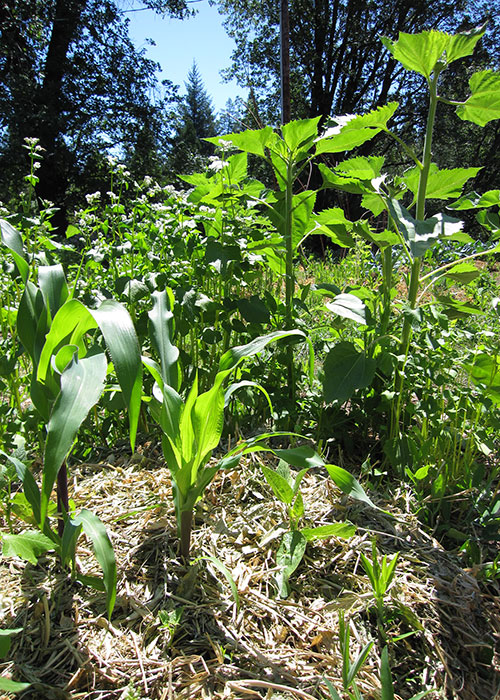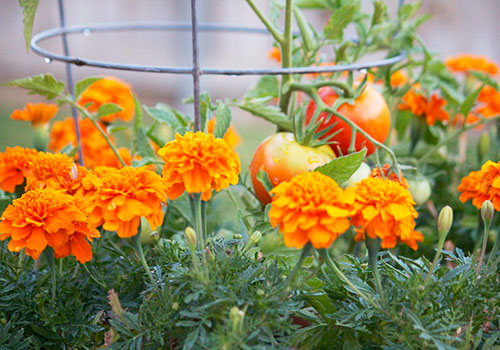Companion Planting
 We get a lot of questions about companion planting at Sky. Many gardeners hope for a straightforward list of compatible plants to make it easy to intercrop their garden beds. But ultimately, charts and lists might be a little too simplistic for the beautifully complex world of plants. Instead, we like to think about companion planting as a creative and flexible process that can change as both you and your garden grow.
We get a lot of questions about companion planting at Sky. Many gardeners hope for a straightforward list of compatible plants to make it easy to intercrop their garden beds. But ultimately, charts and lists might be a little too simplistic for the beautifully complex world of plants. Instead, we like to think about companion planting as a creative and flexible process that can change as both you and your garden grow.
The idea that some plants grow better together is anything but modern. For as long as people have cultivated plants, they’ve worked out the best combinations for their needs and environments. Even without human intervention, plants naturally form communities of different species that are often found together.
A great example of human-guided companion planting with a long history of success is 'Three Sisters' farming, a practice invented and refined by indigenous cultures in North and Central America, who continue the tradition today. The most common sisters, corn, beans, and squash, work closely together to support each other, save space, and replenish the soil as they grow. This is hugely advantageous to monoculture farming (a historically European import).
To make the process simple, gardeners and scientists have tried to catalogue which popular crop plants best benefit each other and to synthesize that information into handy charts. It can’t hurt to give those a try as a starting point, but keep in mind, they've had mixed results when scientists have tried to test them for success.
However, it is true that some plants are more compatible than others. Once you understand the underlying reasons why you might choose to grow certain crops together, you can experiment and find out what combinations work best for you and your garden, and leave the charts behind.

What makes plants compatible?
Good companion plants are a lot like good roommates. Here’s what the bonds of friendship look like between compatible leafy companions.
They have similar tastes “Wait, you like sandy soil? So do I!” When plants have similar tastes, or growing conditions, they’ll thrive under the same conditions. This is the basis for most naturally-occurring plant communities, and you can put it to use in your garden too. For example, try growing basil near your tomatoes — they both love full sun, warm temperatures, lots of nutrients, and well-drained soil.
They know how to share Great companion plants naturally divide up resources without fighting over them. This is good for you because it will help you make maximum use of whatever space you have. Consider how plants might share sunlight, above and below ground space, water, and nutrients. For example, if you are growing a tall plant with deep roots such as eggplants, you might consider planting something low-growing and shallow-rooted like lettuce underneath them.
They protect each other Most pests have favorite food plants, and some plants they actively avoid. Plants that attract different pests or deter each other’s pests make good companions. More diversity in your garden also means more habitat for beneficial insects that eat pests. You’ve probably heard of some plants with especially good reputations as pest-management helpers — such as garlic, marigolds, and dill. But the real key is to plant as many different plant families as you can, and to mix them together instead of giving them each their own separate space.
They help each other out Plants support each other in other ways too. For example, many leafy greens prefer a little shade through the heat of the summer — shade that trellised sun-loving plants like pole beans, cucumbers, or squash can provide. Similarly, legumes like peas and beans are especially great companions for plants that need a lot of nutrients, because their roots harbor friendly microbes that make nitrogen in the air available to plants.
What makes plants antagonistic?
It’s uncommon for plants to be actively antagonistic towards each other, but there are a few reasons they might not get along.
Consider the entire lifecycle of the plants you’re choosing. Are they going to have different care needs, compete for space or resources, or lay out a welcome mat for the same set of pests at any point along the way? If so, they might not be so compatible.
Although it’s less common, there are a few plants that actually slow the growth of certain other plants. Black walnut is a famous example that inhibits the growth of all other plants growing nearby. Onions and garlic grow just fine near most plants, but beans and peas don’t seem to like to grow near them, or in soil where they have grown recently.

Give it a Try!
The best way to learn about companion planting is to give a try. If you want, you can choose a companion planting guide as a template to start from, but you might want to branch out and try your own combinations too. In the end, what works for you will depend on your own space, garden conditions, and gardening style.
